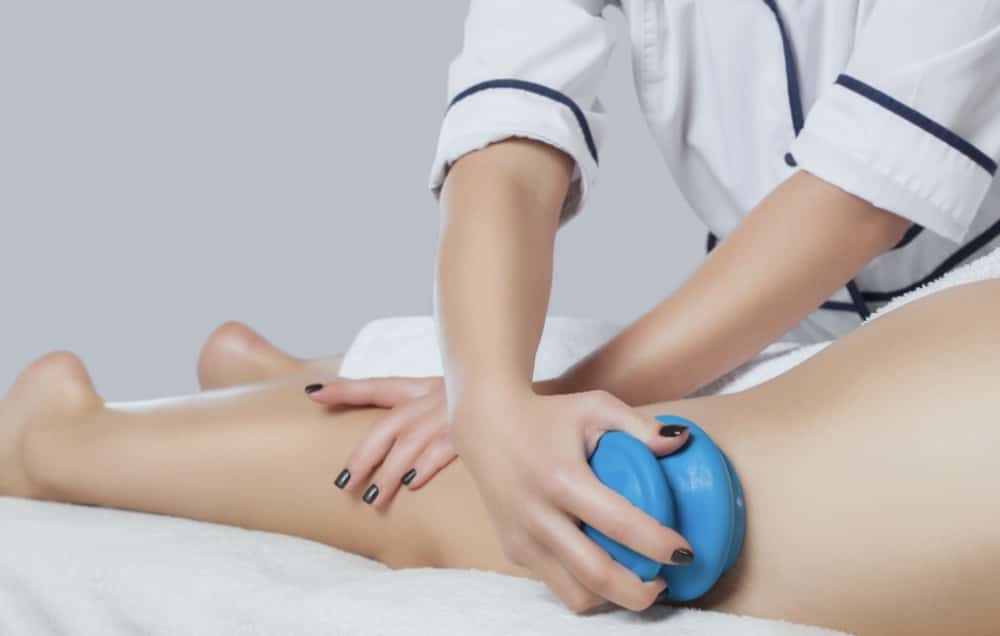Cupping might help lessen cellulite by improving blood circulation, but its scientific support is uncertain. Cellulite, which is just fat pushed through connective tissue, is harmless. Yet, if you’re not a fan of it, trying cupping is an option.
Cupping, an ancient method using suction to pull skin into cups, may temporarily reduce cellulite, though it’s not a primary treatment. Studies suggest cupping can enhance blood flow, pain tolerance, and immune system response.
This article explores cupping’s effectiveness for cellulite.
Table of Contents
What is Cupping?

Cupping, practiced since 3000 BCE across Asia and Europe, is a tool in traditional medicine, aiding in various health concerns from pain to relaxation.
Acupuncturist Robert Youngs explains, “We use suction to bring blood and energy (qi) to the area, meant to break up stagnation, increase circulation, and resolve issues deep in the muscle layers.”
How Does Cupping Work?
Cupping creates suction that brings red blood cells to the area, potentially causing bruising as part of the healing process. This technique increases red blood cells, aiding in healing. Practitioners use cupping marks as diagnostic indicators; darker marks suggest areas needing healing.
While cupping can improve blood flow, lymphatic drainage, and break down fat cells, research on its effectiveness for cellulite is limited and yields mixed results.
Types of Cupping for Cellulite
For cellulite treatment, a combination of cupping and Chinese herbs, taken internally and applied topically, is recommended.
Cupping methods include stationary and running cupping. In running cupping, cups move across the skin while suctioned, using oil for slip.
However, stationary cupping is more common due to potential discomfort with movement.
Initially, cups are left on for 5-10 minutes, increasing to 20 minutes as the person adjusts. Visible changes typically occur within 2-4 visits with 6-8 treatments.
Learn more: Best Cavitation Machines
Does Cupping Work for Cellulite?
The exact mechanism of cupping therapy’s effectiveness remains unclear. However, the theory behind using cupping for cellulite suggests that negative pressure aids in draining accumulated fluids, toxins, and lipids in cellulite.
Cupping promotes circulation and may temporarily smooth the appearance of cellulite. Cupping can be performed using various materials and methods to create suction.
While some studies suggest that cupping therapy decreases the grade of cellulite, research on its long-term effects and effectiveness for cellulite specifically is limited.
Other Benefits of Cupping
Cupping isn’t just for cellulite; it’s been used for a range of issues, including digestive problems, pain management, and vein visibility.
Research suggests that when combined with other treatments like medications or acupuncture, cupping can significantly benefit conditions such as acne, cervical spondylosis, facial paralysis, and herpes zoster.
However, many studies have a high risk of bias, highlighting the need for higher quality research with larger sample sizes.
Additionally, scientific literature suggests cupping may promote skin blood flow, increase pain threshold, reduce inflammation, and modulate the cellular immune system.
Risks of Cupping Therapy for Cellulite
Cupping therapy is generally safe and noninvasive for most adults, but it’s not suitable for everyone.
Consult a doctor before trying cupping if you are pregnant, have heart disease, take blood thinners, have a pacemaker, or have hemophilia.
Avoid cupping on sunburns, skin wounds, recent injuries, fractured bones, varicose veins, or sites of deep vein thrombosis.
While discomfort is common, it’s typically not painful, although some may experience minor dizziness or nausea.
Cupping leaves marks on the skin, which can last from a few days to weeks, and may rarely cause burns or scarring.
Those with skin conditions like eczema or psoriasis should consult a dermatologist before cupping, as it may worsen their condition.
Improperly sterilized equipment can lead to infections such as hepatitis B or hepatitis C due to minor bleeding during cupping. Anemia from blood loss is rare but possible with frequent wet cupping.
Trying Cupping for Cellulite Reduction at a Provider
For safe and effective cupping therapy, it’s advisable to visit a trained professional. When seeking professional treatment, consider acupuncturists, massage therapists, or physical therapists. Ensure the practitioner is experienced and uses thoroughly disinfected equipment.
There’s no specific preparation required, but ensure your skin is clean, and inform the practitioner of any cuts or injuries in the treatment area.
Using Cupping for Cellulite at Home
If you’re into DIY, you can try cupping at home. You can purchase cupping supplies online or at stores selling health, beauty, or massage products.
For safety, opt for silicone cups over glass ones to avoid bruises or burns. Look for kits specifically designed for cellulite treatment, with larger cups for thighs and butt and smaller ones for arms and calves. Ensure cleanliness by sterilizing cups with rubbing alcohol before and after use.
Follow your kit’s instructions, but generally, the process involves applying body lotion or massage oil, placing the cup on the skin, creating a vacuum, gently sliding the cup in circular motions, and repeating 2-3 times per week for 10-15 minutes per area until results are seen.
Treating Bruises After Cupping
If you experience marks after cupping therapy, they’re not typical bruises but may indicate underlying health imbalances, according to Snyder.
To soothe the area, consider using oral arnica or topical arnica, such as Vertly’s Body Lotion.
Youngs suggests using a topical herbal formula commonly used in mixed martial arts to speed up healing.